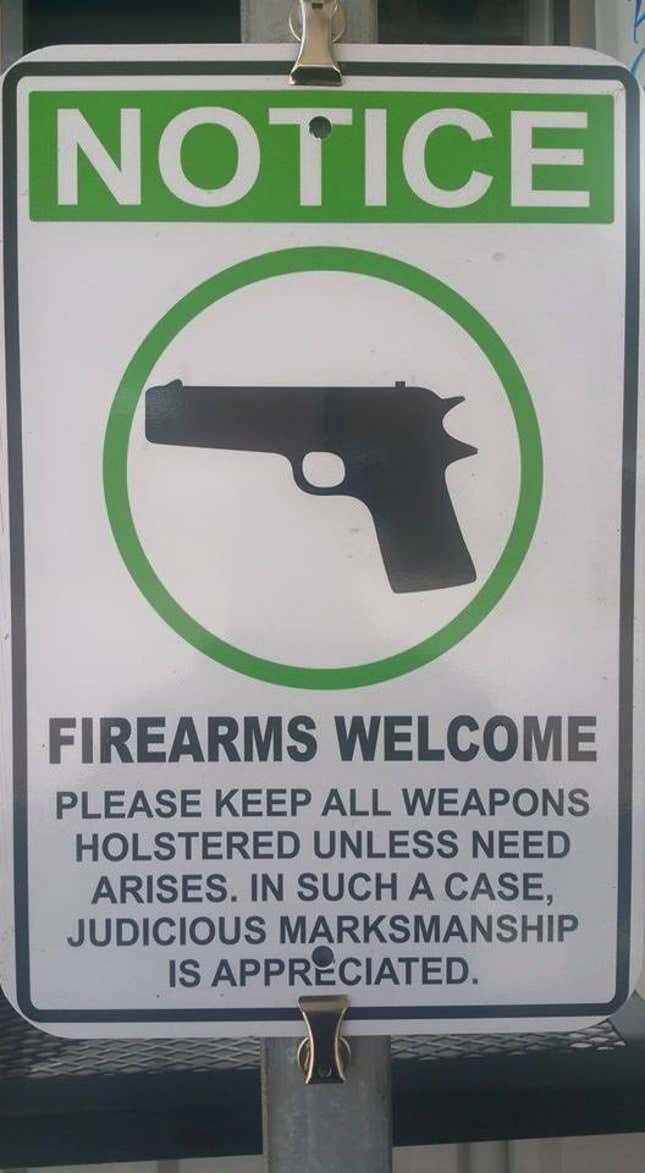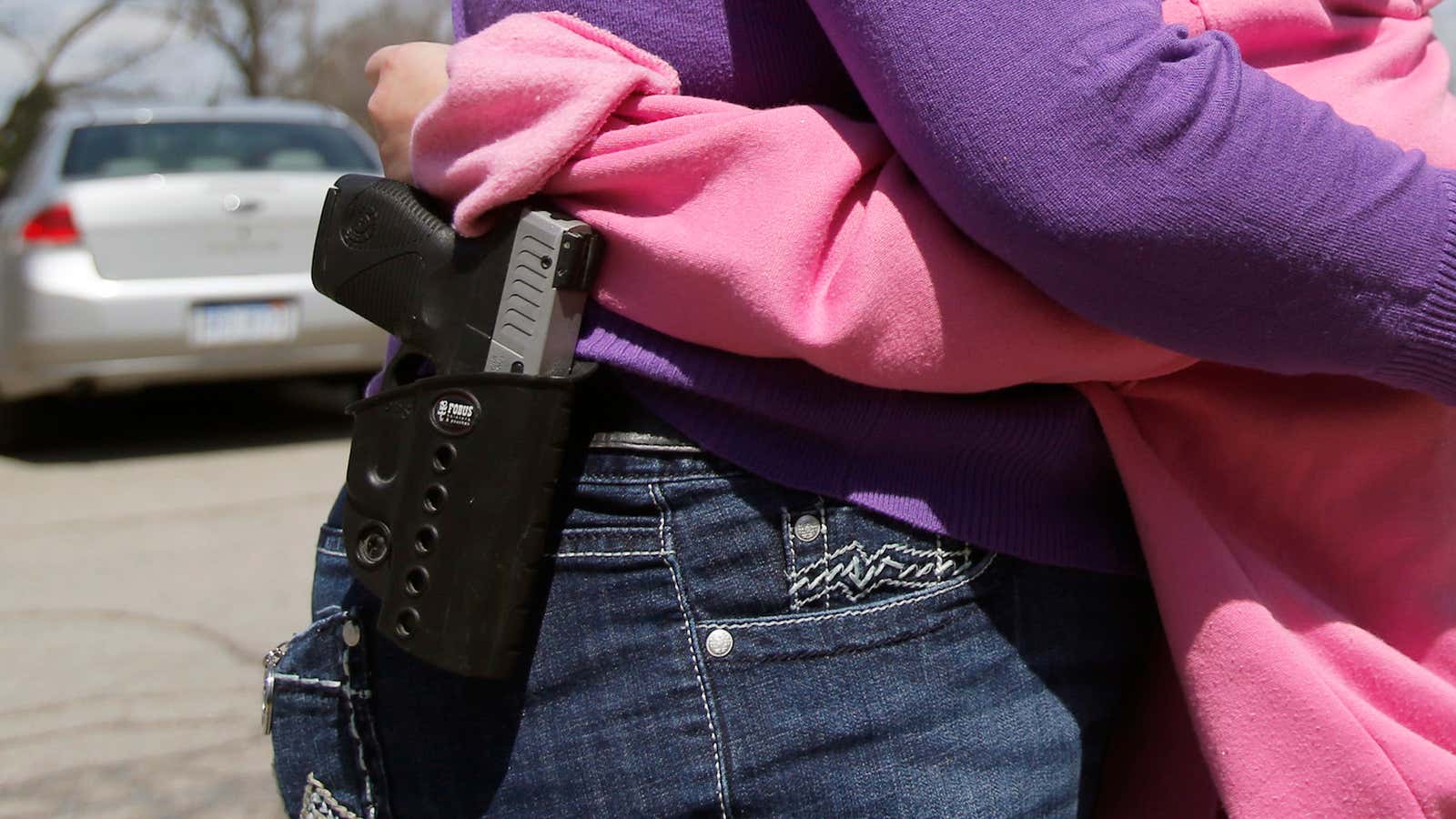In the month since it became legal in Texas to visibly carry a handgun in public, over 3,000 businesses have posted signs banning the practice on their premises, according to Texas3006.com.
Meanwhile, a sign on display at a Houston barbecue joint encourages patrons to open carry.
“Firearms Welcome,” the sign reads. “Please keep all weapons holstered unless need arises. In such a case, judicious marksmanship is appreciated.”

The sign’s written message is tauntingly oblique. It is unclear whether the second sentence, which paints the outline of a potentially fatal situation while pointing out the very obvious, is meant to be humorous. But the sign’s visual message comes across loud and clear. The big green circle around the gun graphic in its center says: “Guns are cool. Show ’em off.”
Similarly, the fight for open carry in Texas is about the ceremonial carrying of expensive guns for all to see.
The primary goal of open carry advocates in Texas seems not to be to promote the safety of civilians, as the NRA argues guns can do. Rather, it is to “condition Texans to feel safe around law-abiding citizens that choose to open carry.” This comes second only to the aim to “educate all Texans about their right to openly carry.” These are two phrases in the mission statement of Open Carry Texas, the group that led the fight to push open carry legislation through the state senate in Texas last year.
The new law has been hailed as a victory by open carry activists, but less vocal gun rights supporters and gun owners don’t feel the same way.
“Open carry is so new it’s kind of novelty for a lot of people. The people I’ve seen open carrying seem like they are trying to make a point,” Alana Barfield, a Houston woman who carries a concealed handgun, tells Quartz.
Barfield carries her 9mm Glock on her “99% of the time” for the purpose of self-protection.
“I feel strongly about the right to protect yourself. I travel for work, by myself, in places where people would be targeted for crime,” Barfield, who works as a freelance makeup artist, says.
She tells Quartz that she has wielded her gun twice to defend herself in the decade she has carried a weapon. On both occasions, Barfield was filling up her car at a gas station late at night when a man approached her. In each case, the men kept coming toward her despite her demands that he stop. So she pulled her gun out from its concealed place on her body, sending the man running.
“The decision to pull out my gun is not one I take lightly,” Barfield tells Quartz. “In gun safety classes they teach you that if you pull out your weapon, you better be ready to shoot.”
Close to one million people in Texas have license-to-carry permits—more than 3% of the state’s population. Yet Texas is the 5th-to-last state in the US to allow its residents to openly carry a firearm.
The reason for this is closely tied to the state’s confederate history.
“In the antebellum period, no states restricted open carry, and only some southern states, excluding Texas, banned concealed carry,” Stephen Halbrook, a lawyer who specializes in gun policy, writes in an email to Quartz.
The ban on carrying guns (concealed or not) in public in Texas was put in place after the US Civil War, when carpetbagger Republicans took control of the state government in the 1870s. Later, when Southern Democrats regained control of the state, the law was selectively enforced to disarm black and Hispanic people, according to Constitutional law historian Clayton Cramer.
In 1996, the concealed carrying of weapons became legal in Texas again—and, until January 1 this year, the ban on open carry remained.
“On gun laws in particular, suggestions for reform are met with ‘the sky is falling!’” Hallbrook says. But “once a law is passed, inertia takes hold.”
Those who carry concealed weapons cite the fear of being fined for inadvertently revealing their weapon as a reason they support the passage of open carry legislation.
“While I don’t fully open carry, if I reach up for that thing on the top shelf of the grocery store, it’s not a felony. So, I love it for that,” Barfield said.
In Florida, where concealed carry became legal in 1987, this concern has generated enough interest of late that the Florida Sheriff’s Association just proposed a new law that would grant immunity to licensed carriers who accidently flash their gun in public.
“This solution is a solid alternative to opening the door to full-blown open carry, which creates significant public safety challenges for law enforcement,” Pinellas County Sherriff Bob Gualtieri told Florida’s News Channel 8.
Paradoxically, Open Carry Texas lists its fourth and final aim as to “foster a cooperative relationship with local law enforcement in the furtherance of these goals with an eye towards preventing negative encounters.”
But law enforcement officials in Texas have had to develop new training programs to teach officers how to respond to threats in light of open carry, and carrying a gun in a visible location on your body can actually backfire if you’re faced with someone who is trying to commit an armed crime.
“You’re probably going to be the first target they want to take down,” Kathy Simmons, a shooting instructor who teaches concealed handgun license courses, tells Quartz.
Simmons teaches around 100 people a year how to wield a gun in self-defense at her ranch in Segovia, Texas. Her courses are tailored toward mothers who want to carry a handgun as a last line of defense against criminals coming after their families. Simmons emphasizes the “element of surprise” to them as the biggest benefit of carrying a concealed weapon.
“If a 200 pound man has watched you walk around a store with a gun on your hip, you are at risk that he could overpower you and use the your weapon against you. You lose that element of surprise, and I always say that that element of surprise is your greatest weapon,” Simmons says.
Simmons says she carries a gun on her body at almost all times, but she says she will not open carry.
Barfield won’t either. She equates carrying a gun in a visible location on her body to “flashing around a diamond ring.” She says she doesn’t want “that kind of attention,” nor does she want to send the wrong message.
“While I have every right to go into places with a gun on my hip, I am going to keep it concealed,” Barfield tells Quartz. “The last thing I want to do is get in a gunfight. Just imagine the paperwork!”




